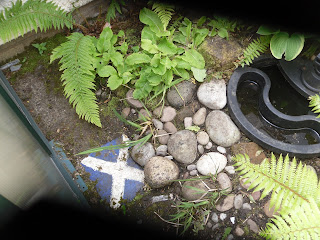The last meeting till after the summer!
It is the day of the P7 Leaver’s Dance so some of our
members were not here. But for those who were it was busy and exciting.
We all signed a “thank you” card for Mr and Mrs McKelvie
before we went outside. Then we had a wee look at the courtyard and saw some
flowers on the alpine strawberries – so even if Mrs Morrison had knocked them
over they seem to have survived! A few had died but we can get more next year.
The poppy has big buds on it and a wee single poppy has
flowered – it must have come in as a seed because we did not plant it.
Mrs Whyte and Mrs Thomson took one group to edge round the
big bed at the front entrance. That made the grass looks much neater. They also
cut back large chunks of the conifer tree that had brown dead branches so it
looked better and would grow again.
Mrs Morrison took another group to the raised beds where we
did some weeding. It is amazing how the weeds seem sometimes to grow better
than the things we have planted!
We found the first pea pods (not fully grown yet) and a
couple of tiny bean pods. The peas have not grown very well but the beans are
full of flowers. If our nest lot of peas germinate well in the greenhouse, Mrs
Morrison will plant them out over the summer.
We each got a radish – it is only two weeks since we thinned
them but they are fully grown now. It is just as well we thinned them out so
they had room to grow. Some were a round ball shape and some were more like
cylinders because we had planted two different types of radish.
We all each also got a (very wee) lettuce from the
thinnings.
Some of us planted wallflower seeds so that we can plant
them out in the autumn where the begonias are just now at the main entrance.
And we also planted a planter full of gladioli. They should be well up when we
get back after the summer and then flower in September. The planter is next to
the dahlia.
Then some of the mums and dads and grans and grandpas
arrived to see our garden. We showed them the raspberries and strawberries, the
peas and beans, the turnips, the lettuces, the carrots, the radish and spring
onions; all in the raised beds. We showed them the cucumber (it is looking a
wee bit peely wally poor soul), the various tomato plants (there are a few
flowers on two of them), the courgettes and the pumpkin in the green house. We
showed them the sweet pea wigwam and the dahlia (my, how that has grown
already). We showed them the fruit trees, the flowers at the main entrance, and,
inside the school, we showed them the courtyard.
We also showed them the sweet peas and the sunflowers which
are getting taller by the day
Mr and Mrs McKelvie came to visit as well so we gave them
the “thank you” card. Mr McKelvie had brought a present for those who did not get
a plant from him last week. So everyone got an “Ornithogalum” which needs to be
watered sparingly about maybe once a week. Its common name is the False Sea
Onion and its proper name is Ornithogalum Caudatum or Ornithogalum Longebracteatum
– what a mouthful! Let’s hope we manage to keep them all alive. Mr McKelvie
also said that he had lots of alpine strawberries so we could get some more
from him to fill the gaps where some of ours had died.
We gave everyone who was at the club a wee note of the web
site for this blog and a reminder that the first meeting next term will be on
Tuesday 18th August – see you all there.






































